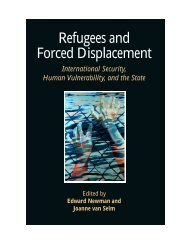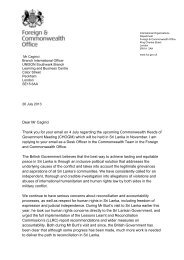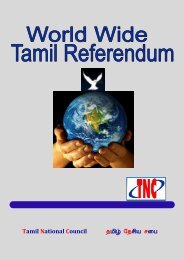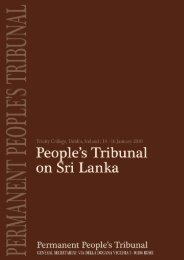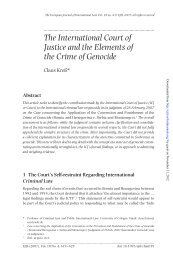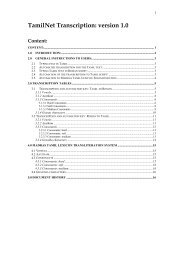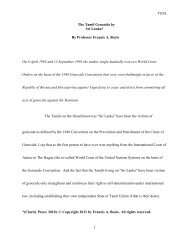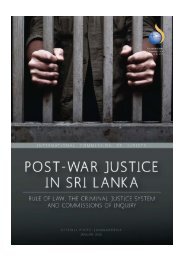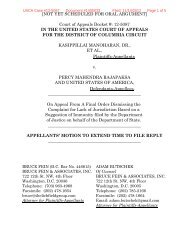Proposal to encode characters for Extended Tamil §1 ... - TamilNet
Proposal to encode characters for Extended Tamil §1 ... - TamilNet
Proposal to encode characters for Extended Tamil §1 ... - TamilNet
You also want an ePaper? Increase the reach of your titles
YUMPU automatically turns print PDFs into web optimized ePapers that Google loves.
except <strong>for</strong> the single ligature K·SSA, consonants are written with visible virama asappropriate (in one variant of ET-L with Grantha-style virama glyph <strong>for</strong> Grantha-styleconsonants not existing in <strong>Tamil</strong> and <strong>Tamil</strong>-style <strong>for</strong> native <strong>Tamil</strong> consonants).§7. Collation and linebreakingAs the language being represented is Sanskrit, the Sanskrit collation order (described indetail in my Grantha proposal L2/09-372 <strong>§1</strong>0) is <strong>to</strong> be followed. It is <strong>to</strong> be remembered thatnative <strong>Tamil</strong> <strong>characters</strong> and newly <strong>Tamil</strong> <strong>Extended</strong> <strong>characters</strong> which be naturally mixed upin the sorting order. The rules <strong>for</strong> line breaking are as in <strong>Tamil</strong>.§8. Unicode character properties8.1. DiscussionI have already discussed in L2/10-085 whether <strong>to</strong> <strong>encode</strong> these <strong>characters</strong> in the <strong>Tamil</strong>block or elsewhere. Since the positions in the <strong>Tamil</strong> block corresponding <strong>to</strong> the ‘missing’<strong>characters</strong> from other blocks are yet empty, it would be very easy <strong>to</strong> simply fill in thosecodepoints. However, I strongly suspect that it would not be welcomed by some parties thatare already asking <strong>for</strong> the removal of Grantha-style <strong>characters</strong> from the <strong>Tamil</strong> block (whichis of course absurd). There<strong>for</strong>e, <strong>to</strong> avoid such a problem, these <strong>characters</strong> may be <strong>encode</strong>din a separate “<strong>Tamil</strong> <strong>Extended</strong>” block (just like “Devanagari <strong>Extended</strong>”), another name <strong>for</strong>the <strong>Tamil</strong> Supplementary block I requested in L2/09-317. They may be placed sequentially.Regarding the character names, I felt that it is better <strong>to</strong> name these <strong>characters</strong>beginning with the words TAMIL EXTENDED and not just TAMIL. However, as per instructionsfrom the UTC I have used just TAMIL. For the anusvara and visarga, however, I had <strong>to</strong>introduce the adjectives SPACING and GRANTHA-STYLE <strong>to</strong> differentiate them from the existing“anusvara” and “visarga” <strong>characters</strong> in the <strong>Tamil</strong> block 0B82 and 0B83.There is only one point about naming I would like <strong>to</strong> mention, however. Everywhereelse (Devanagari, Gujarati etc), the anunasika sign has been named SIGNCANDRABINDU and not SIGN ANUNASIKA. Here, however, I request <strong>for</strong> the anunasikacharacter <strong>to</strong> be named anunasika and not candrabindu. The reason is that, as I havementioned above, there are many variants <strong>to</strong> <strong>Extended</strong> <strong>Tamil</strong>, and not all of them use thecandrabindu <strong>for</strong> the anunasika, as I have remarked above in §6.1. There<strong>for</strong>e, it would not beappropriate this character CANDRABINDU, and there<strong>for</strong>e I ask <strong>for</strong> it <strong>to</strong> be named TAMILEXTENDED SIGN ANUNASIKA.11




